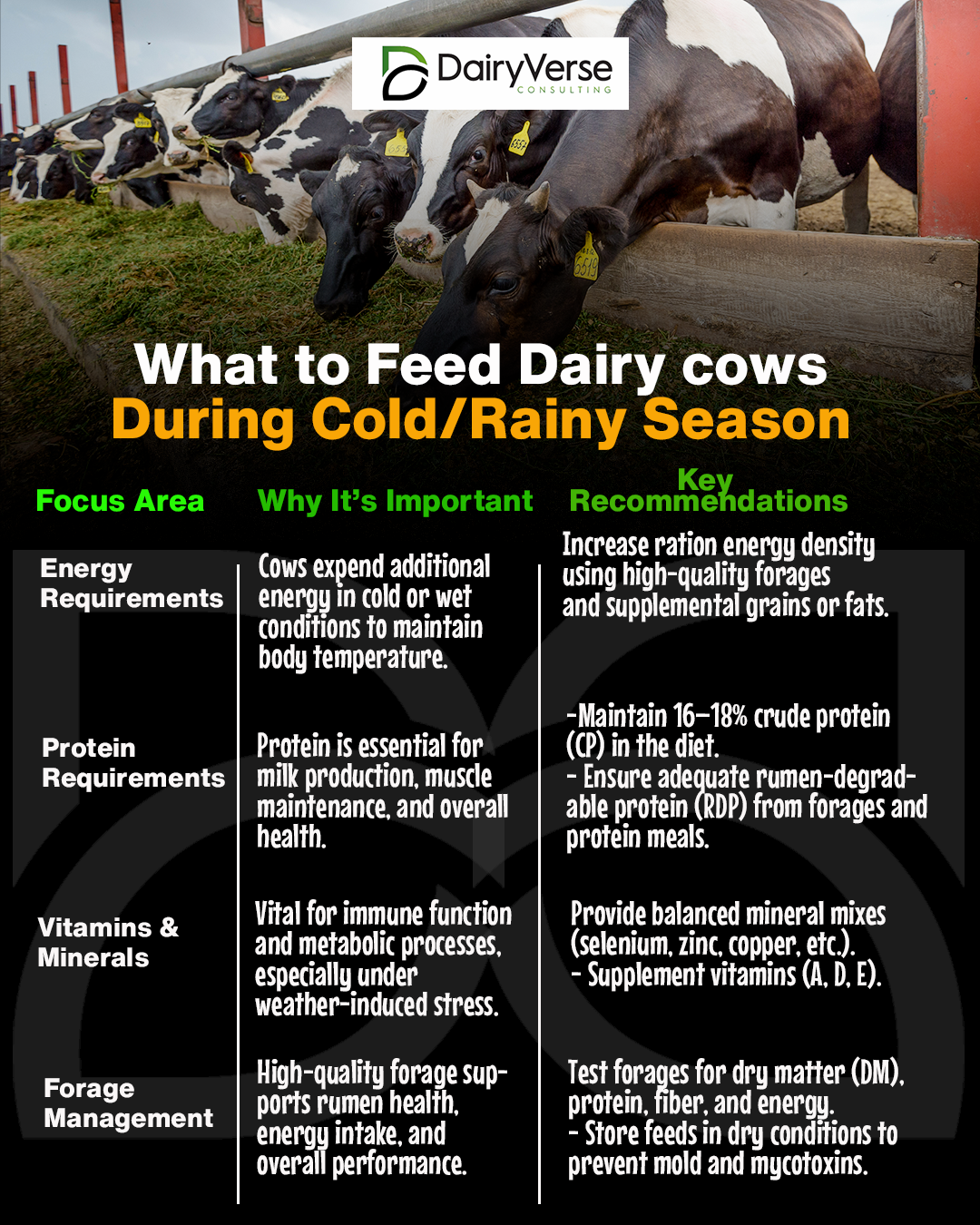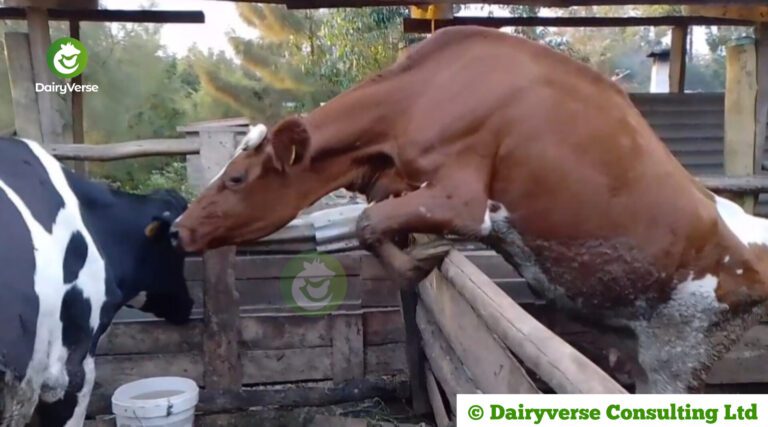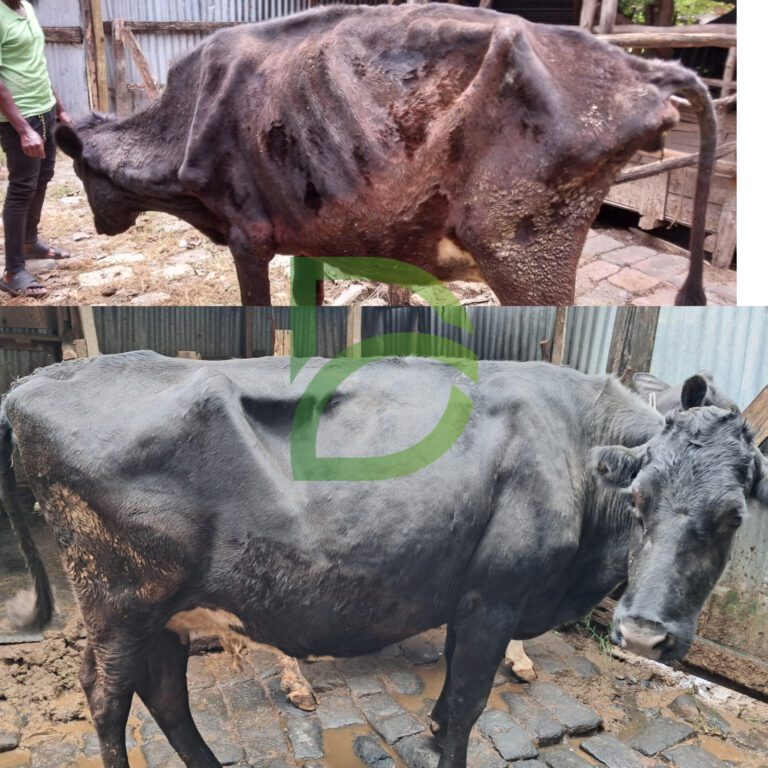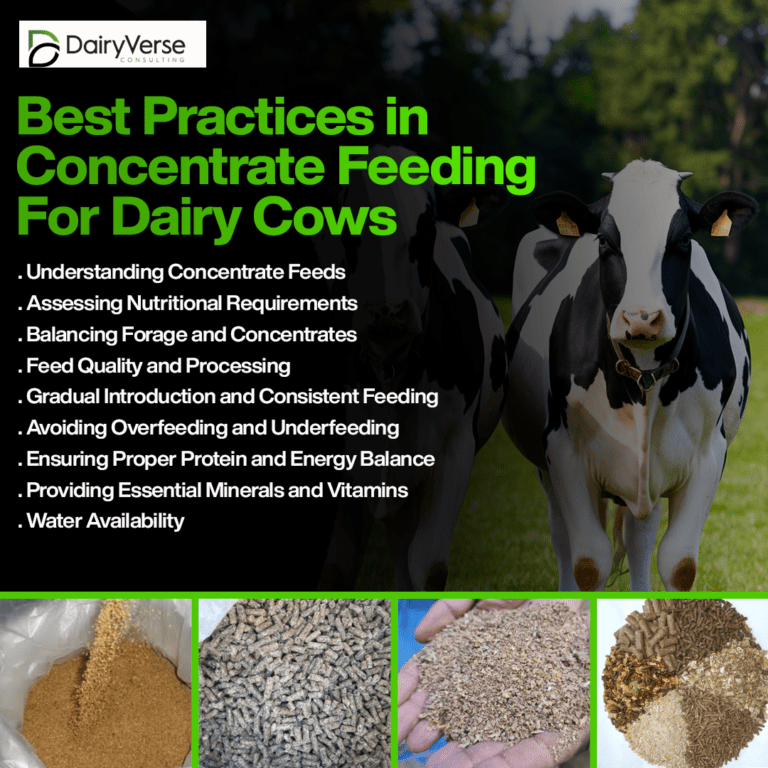Feeding Dairy Cows During the Cold or Rainy Season
Feeding dairy cows during cold or rainy seasons poses unique challenges that can impact herd productivity, health, and overall profitability. This guide provides practical, research-based recommendations to ensure cows remain healthy, maintain body condition, and continue to produce high-quality milk through adverse weather.
1. Understand the Nutritional Requirements
1.1 Increased Energy Needs
During cold or rainy conditions, dairy cows burn more energy to keep warm. Research shows that the lower critical temperature (LCT) for dairy cows can vary by breed and hair coat condition, but for most healthy adult cows with a winter coat, it often falls around 5–10°C (41–50°F). Below this threshold, cows must use more energy to stay warm.
- Increase in ration energy density: To compensate for this higher energy demand, rations should contain more energy-dense ingredients, such as good-quality forages and, if necessary, supplemental grains or fats.
1.2 Protein Requirements
While energy is vital for temperature regulation, protein remains essential for milk production and maintenance of muscle mass.
- Crude protein (CP) levels: Aim to supply 16–18% CP in the diet, depending on the stage of lactation, body condition, and milk yield.
- Rumen-degradable protein (RDP): Ensure enough RDP from high-quality forages and protein concentrates (e.g., soybean meal, canola meal) to meet microbial protein synthesis needs. This helps optimize digestion and feed efficiency.
1.3 Vitamins and Minerals
Vitamins and minerals are crucial all year round but can become even more important during stressful periods such as prolonged rainfall or cold.
- Trace mineral supplementation: Provide balanced mineral mixes containing trace elements (selenium, zinc, copper, etc.) to maintain immune function.
- Vitamin A, D, and E: Adequate levels improve immune response and overall health, especially important in lower-sunlight conditions or when cows cannot graze fresh pasture.
2. Practical Feeding Strategies
2.1 Feed Quality and Forage Management
- Secure enough high-quality forage: Forages (silage, hay, haylage) should be harvested correctly to avoid mold and spoilage, which can increase in damp conditions.
- Test forage: Conduct regular forage testing to determine dry matter (DM), protein, fiber, and energy levels. Adjust feeding strategies accordingly.
- Manage mold and mycotoxins: Damp and humid weather encourages mold growth. Store feeds under dry, cool conditions. Use preservatives or mycotoxin binders when necessary.
2.2 Balancing Rations with Supplements
- Energy supplements: Incorporate concentrates like corn, barley, or commercial dairy concentrates to meet energy demands if forage quality or quantity is limited.
- Protein supplements: If forage protein is insufficient, use soybean meal, canola meal, or urea-based supplements.
- By-product feeds: Wet by-products (e.g., brewer’s grains or wet distiller’s grains) can be used carefully to increase ration moisture and energy but must be stored properly to prevent spoilage.
2.3 Total Mixed Rations (TMR) vs. Component Feeding
- TMR: A consistent TMR ration ensures even distribution of nutrients, prevents selective feeding, and optimizes rumen function. Use a mixer wagon and maintain recommended chop length to encourage rumination.
- Component feeding: If TMR is not feasible, carefully manage the sequence of feed offerings (forage before concentrates) to avoid rumen acidosis and to maintain stable intake during bad weather.
3. Management Considerations in Cold or Rainy Weather
3.1 Shelter and Housing
- Dry, comfortable housing: Provide adequate bedding (straw, sawdust, or mats) to keep cows dry, reduce stress, and maintain body temperature.
- Ventilation: Even in cold or rainy weather, ensure sufficient airflow to minimize respiratory issues. High humidity can lead to damp bedding and increased pathogen load.
- Windbreaks: Outdoor-housed cows need windbreaks or sheltered areas to reduce wind chill and maintain warmth.
3.2 Feeding Management During Wet Conditions
- Timing and frequency: Offering feed more often or in smaller batches can keep it fresh and more palatable.
- Protect the feed: If feeding outdoors, consider covered troughs or feed bunks to minimize rain damage to the ration. Spoiled or wet feeds reduce intake and nutritional value.
- Observe body condition: It can be easy for cows to lose body condition in poor weather if their increased energy needs are not met. Body Condition Scores (BCS) should be monitored monthly.
3.3 Water Availability
- Constant supply of clean water: Cold weather can lead to freezing water troughs, while heavy rains can introduce contamination or runoff. Regularly check and clean water sources.
- Prevent ice formation: Use de-icers or insulated water troughs, if necessary, to ensure availability of water around the clock.
3.4 Health and Disease Prevention
- Immune support: Proper feeding, mineral supplementation, and minimal stress will help cows maintain immunity against respiratory ailments and mastitis, which can spike in damp, cold conditions.
- Regular health checks: Watch for signs of pneumonia, ketosis, milk fever, and other metabolic or nutritional disorders. Early detection and treatment are critical.
4. Special Considerations for Different Groups
4.1 High-Producing Lactating Cows
These cows have the highest nutrient demands, especially energy and protein. Ensure they receive adequate nutrients to maintain milk yield.
- Frequent ration checks: Small ration imbalances can quickly manifest in production drops.
- Monitor rumen fill and cud chewing: They’re good indicators of ration effectiveness and forage quality.
4.2 Dry Cows and Transition Cows
Proper feeding during the dry period sets the stage for healthy calving and lactation.
- Maintain moderate BCS (around 3.0 to 3.25): Over-conditioned cows risk metabolic disorders, while under-conditioned cows can struggle with calving and milk production.
- Balanced minerals: Provide the right calcium and phosphorus ratio to reduce milk fever risk.
4.3 Heifers and Young Stock
Growing animals need sufficient protein and energy for optimal growth. In cold weather, their energy demand increases to maintain body temperature.
- Prioritize consistent growth: Avoid growth slumps caused by inadequate winter feeding.
- Monitor for pneumonia: Younger animals are more susceptible to respiratory issues in cold, wet conditions.
5. Economic Considerations
5.1 Feed Budgeting and Planning
- Storage and inventory: Well-planned feed inventory reduces emergency purchases at premium prices.
- Seasonal price fluctuations: Prices of certain feed ingredients can spike in the off-season. Purchasing and storing in advance can offer cost savings.
5.2 Minimizing Feed Waste
- Proper storage: Protect bagged concentrates and baled hay from water damage.
- Efficient feeding systems: Use appropriate troughs or automatic feeders to reduce feed spillage and spoilage.
6. Conclusion
Feeding dairy cows during the cold or rainy season requires a careful balance of energy, protein, vitamins, minerals, and well-managed forages. By prioritizing shelter, clean water, balanced rations, and regular body condition monitoring, farmers can ensure that their herds remain healthy, productive, and resilient during periods of adverse weather. Regularly consult with a dairy nutritionist or extension specialist to tailor feeding strategies to local conditions and herd-specific needs.
When executed correctly, these recommendations can help maintain peak milk production, bolster immunity, and ensure the wellbeing of the herd—ultimately securing profitability and long-term sustainability for the dairy operation.







